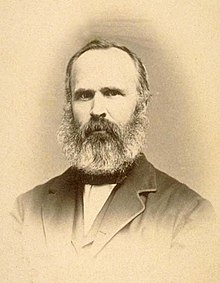Josiah D. Whitney
Josiah Dwight Whitney (born November 23, 1819 in Northampton , Massachusetts , † August 15, 1896 in Lake Sunapee , New Hampshire ) was an American geologist . He was a California State Geologist and Professor at Harvard University .
Life
Whitney studied chemistry, astronomy and mineralogy at Yale University from 1836 , graduating in 1839, and went to the New Hampshire Geological Survey in 1840 as an unpaid assistant to Charles T. Jackson . Afterwards he originally wanted to study law, but under the impression of a lecture by Charles Lyell switched to geology and continued his studies of chemistry and geology in Europe (France, Germany) in 1842.
On his return in 1847 he was with John Wells Foster assistant to Charles T. Jackson in the geological survey of Northern Michigan and Lake Superior . After Jackson left, he continued this with Foster and both published their report in 1850. The exploration of this mineral-rich area made him a deposit expert and he subsequently advised mining companies. In 1850 Whitney was elected to the American Academy of Arts and Sciences . In 1854 his book about the mineral resources of the USA appeared. He was then in the geological exploration of Iowa (Report 1858/59) and the upper Missouri (Report 1862) with James Hall (Report 1859/59). He also became a professor at Iowa State University in 1855 .
From 1860 he was head of the California Geological Survey, which, however, increasingly the funds were canceled and which was set in 1868. One reason was that Whitney also pursued palaeontology, zoology and botany on a broad basis in the land survey (led by botanist William Henry Brewer , to which Clarence King , James Terry Gardiner and Charles F. Hoffmann also joined), but primarily to his clients Mineral resources, especially gold deposits, were interested. Whitney retained the title of State Geologist until 1874, but no geological survey was carried out. However, he published the results, partly self-financed. The State Mining Bureau, founded in 1880, dealt only with natural resources and mining and did not even hire a geologist until 1928. The ambitious program of Whitney's land survey of California influenced later ventures of this kind and the establishment of the US Geological Survey.
In 1863 Whitney was a founding member of the National Academy of Sciences . In 1865 he became a professor of geology at Harvard, where he should establish a mining education. Whitney could not devote himself to the task until 1874, after his position as state geologist in California came to an end.
He was an early proponent of a national park in the Yosemite Valley and published a book about the valley. With John Muir he got into a dispute because he denied the glacial origin of the valley represented by Muir, from which he never abandoned. According to Whitney, the valley was formed when the bottom sagged.
He is also best known for his role in the Hoax for the Calaveras Skull , a human skull found in Calaveras County in 1866 that was believed to be from the Pliocene , which Whitney advocated. In 1879, Thomas Wilson at Harvard showed by the fluorine content that he was much younger.
He was married to the writer Louisa Goddard (1819–1882) since 1854. With her he had a daughter Eleanor (1856-1882), after whom he named Lake Eleanor in Yosemite National Park.
In 1869 he and William H. Brewer determined the height of the highest peaks in the Rocky Mountains. In recognition of this, Mount Whitney was named after him. The Whitney Glacier on Mount Shasta is also named after him. He was elected to the Geological Society of London .
Fonts - excerpt
- Metallic Wealth of the United States . Philadelphia 1854
- The Yosemite Book 1869 . yosemite.ca.us
- The Geological Survey of California , 1864-1870
- The Geological Survey of California: An Address Delivered Before the Legislature of California at Sacramento, Tuesday Evening, March 12th . 1861. By JD Whitney, State Geologist. Towne & Bacon, 1861; Text archive - Internet Archive
- Geology . Vol. I. Report of Progress and Synopsis of the Field Work from 1860 to 1864 . Published by Authority of the Legislature of California. Caxton Press of Sherman & Co., etc., etc. 1865; Text archive - Internet Archive
- Geology . Vol. II. The Coast Ranges . 1882; Text archive - Internet Archive
He published the book by Jöns Jakob Berzelius about soldering tube samples in America.
- Publications by Josiah Dwight Whitney. Internet Archive
literature
- Edward T. Brewster: Life and Letters of Josiah Dwight Whitney . Houghton Mifflin company, Boston / New York 1909; Text archive - Internet Archive
- Whitney, Josiah Dwight . In: Encyclopædia Britannica . 11th edition. tape 28 : Vetch - Zymotic Diseases . London 1911, p. 611 (English, full text [ Wikisource ]).
Individual evidence
- ^ John Wells Foster, Josiah Dwight Whitney: Report on the Geology and Topography of a Portion of the Lake Superior Land District in the State of Michigan . Part I: Copper Lands . Printed for the House of Reps. 1850; Text archive - Internet Archive
- ^ The Metallic Wealth of the United States: Described and Compared with that of Other Countries . Text archive - Internet Archive
- ^ John Muir exhibition. Sierra Club
| personal data | |
|---|---|
| SURNAME | Whitney, Josiah D. |
| ALTERNATIVE NAMES | Whitney, Josiah Dwight (full name) |
| BRIEF DESCRIPTION | American geologist |
| DATE OF BIRTH | November 23, 1819 |
| PLACE OF BIRTH | Northampton , Massachusetts |
| DATE OF DEATH | August 15, 1896 |
| Place of death | Lake Sunapee , New Hampshire |
